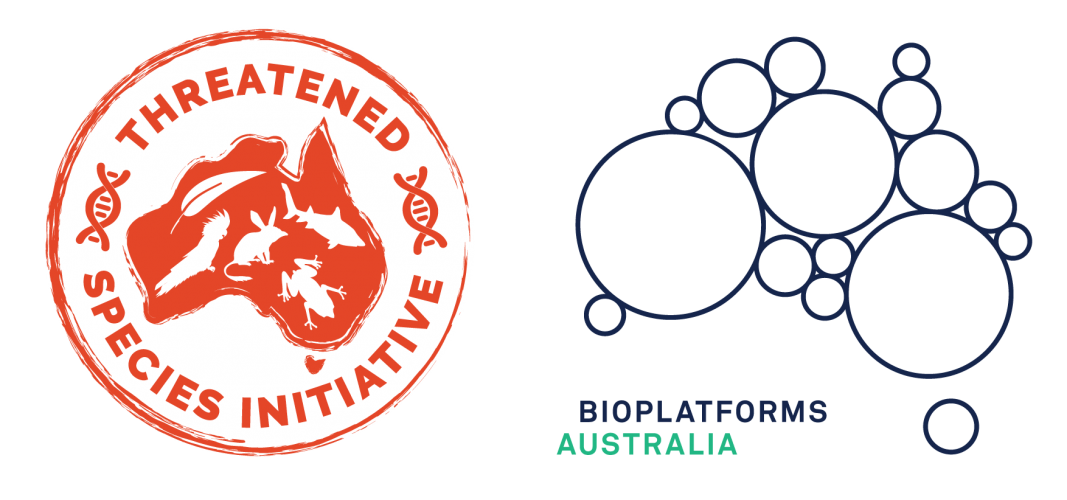Request for Partnership Process
REQUEST FOR PARTNERSHIP 2024 IS NOW OPEN
Please ensure you have read all information on this page before completing your application
PRIORITY SPECIES
The Threatened Species Initiative (TSI) has been building a foundation of genomic data to enhance the conservation of threatened species based on consultations with the Federal, State and Territory threatened species managers, existing Bioplatforms Australia framework initiatives, and the 2021 Commonwealth government 100 Priority Species List.
Please see the list of active programs that were approved in previous RFP rounds.
The initiative now would like to extend the range of targeted threatened species, including insects and invertebrates. Applications for partnership are encouraged to target species that have active conservation action plans or those where evidence of need for genomic data to support conservation actions can be articulated.
We will prioritise projects on species where genetic information would have an immediate tangible impact.
A FOCUS ON APPLIED OUTCOMES
The below questions represent some examples where genetic information can have a substantial impact on improving conservation outcomes. Partnership projects are not expected to resolve all of these questions, or only these questions.
- What is the population diversity and potential inbreeding effects in populations of reduced habitat or range?
- What is the current genetic status of captive or translocated populations? And how are they performing relative to wild populations?
- What is the genetic divergence of isolated or disjunct populations? (to determine appropriate management actions/units)
- Will populations benefit from transferring new individuals from/into the population? If so, which population is the best option for transferring individuals with?
- What are the differences/commonalities between putative source populations and receiving populations during translocations?
- What is the reproductive contribution of released/translocated individuals?
- What are the best potential founder relationships for insurance populations and/or translocation programs?
- How can we best manage the genetic diversity in ex-situ collections (e.g. zoo populations, seed banks, botanic garden collections)?
- [for animals] What is the parentage information for captive, or intensively managed translocated wild populations? What are the pedigrees of unknown animals in group-housed populations? What is the reproductive skew (over-representation of genetic lines) that will impact long-term genetic diversity within a managed population (island, fenced, geographically isolated, captive etc.)?
- [for plants] What is the presence or extent of clonality? And what is the risk for and extent of hybridisation?
REQUEST FOR PARTNERSHIP
The 2024 call for projects is now open.
Projects are must target a threatened species with conservation needs and will be assessed based on the following criteria:
- End-user collaboration: proven collaboration with the relevant species conservation group/s – shown through a statement of intent from the end-user for the use of the genetic data outputs.
- Species: the species must either have –
- an active management/conservation plan that identifies the need to collect genetic information and/or actions that are informed by, or would be improved with, genetic information (e.g. the species is part of a rehabilitation/breeding and translocation program).
- an articulation and evidence of need for genomic data to support conservation actions (defining the issue and why/how genomic data would assist).
- Team: a team with the required bioinformatics capacity to sequence, curate, map and make publicly available the draft genome sequence using the latest technologies, and the capacity to undertake the companion studies necessary to address relevant management questions.
- Scientific rigor: proven access to existing samples, or the ability to collect samples in a timely manner, that are suitable for extracting high molecular weight DNA for high-quality genomic sequencing (for both whole genome sequencing and reduced representation sequencing)
- Co-contribution: the team must be capable of marshalling the funding necessary to complement the Bioplatforms Australia component (sequencing only), in order to bring the project to completion. Sample collection and data analysis are to be supported by co-investment. The ability to conduct value-add sequencing is highly desirable.
It should be noted that this is not a grant opportunity. The sequencing will be undertaken by Bioplatforms Australia facilities through the Framework Initiative Program, while sample collection, the provision of DNA/RNA suitable for sequencing, and subsequent informatics is to be supported by the research community. Note: TSI will be able to assist in connections to expertise if required.
INSTRUCTIONS FOR APPLYING
- Please ensure you have read all information on this page before completing your application.
- Complete the online form here and submit one document per species or activity. For preparation purposes, you can find a downloadable template here.
- Address all criteria/questions listed, you will be able to edit the form after its submission and until the deadline.
Deadline: COB 19th July, 2024
Contact information:
Sophie Mazard, Project Manager, smazard@bioplatforms.com
Carolyn Hogg, Science Lead, carolyn.hogg@sydney.edu.au
We welcome collaboration and parties interested in participating in the TSI Program, including this RFP, are welcome to get in contact with Sophie Mazard.
